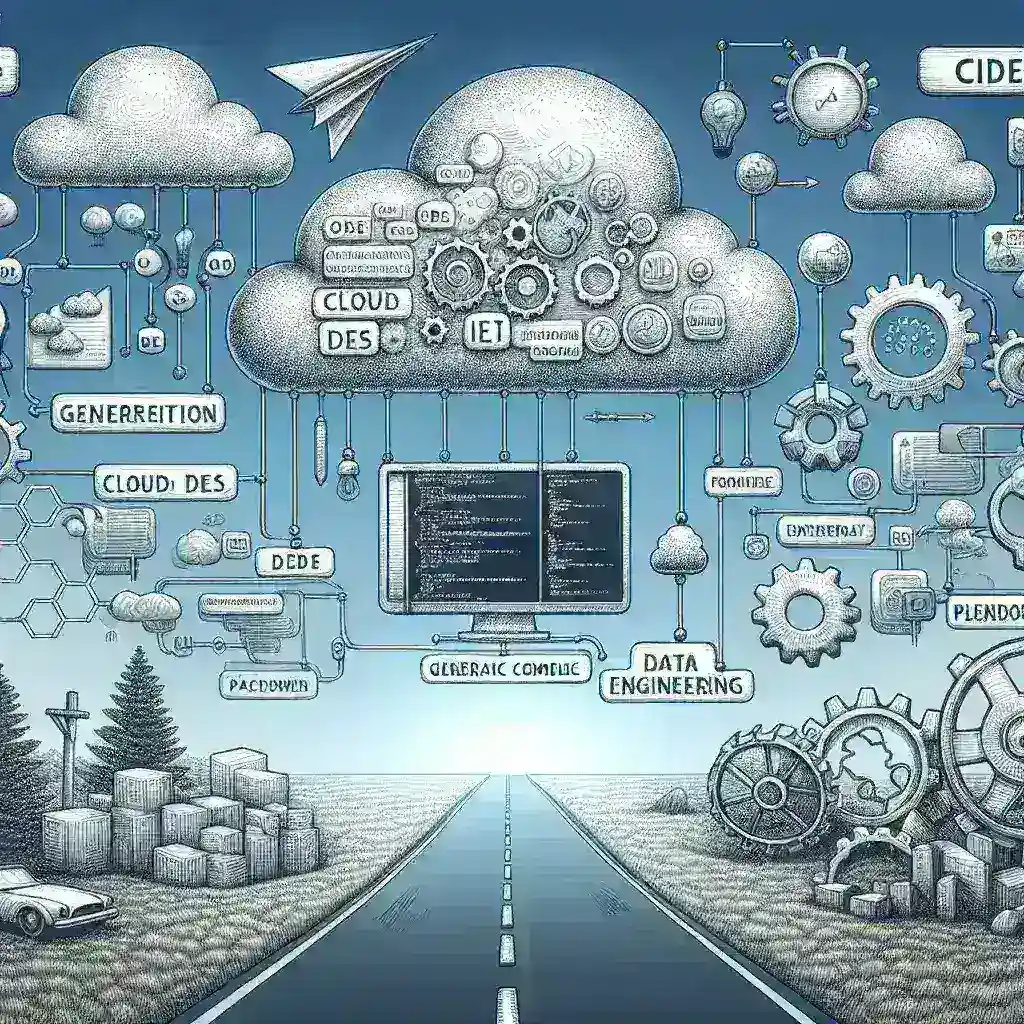The landscape of data engineering has undergone a revolutionary transformation with the advent of cloud-based Integrated Development Environments (IDEs). These powerful platforms have democratized access to sophisticated data processing tools, enabling engineers to build, test, and deploy data pipelines without the constraints of local hardware limitations. As organizations increasingly migrate to cloud-first architectures, the selection of an appropriate cloud IDE becomes a critical decision that can significantly impact productivity, collaboration, and project outcomes.
Understanding Cloud IDEs in Data Engineering Context
Cloud IDEs represent a paradigm shift from traditional desktop-based development environments. These browser-accessible platforms provide comprehensive development tools, including code editors, debuggers, version control integration, and execution environments, all hosted in the cloud. For data engineers, this translates to immediate access to scalable computing resources, pre-configured environments for popular data processing frameworks, and seamless collaboration capabilities.
The evolution of cloud IDEs has been particularly beneficial for data engineering workflows, which often require substantial computational resources for processing large datasets, running complex algorithms, and testing distributed systems. Unlike conventional development setups that might struggle with memory-intensive operations or require extensive local configuration, cloud IDEs offer virtually unlimited scalability and come pre-equipped with essential data engineering libraries and tools.
Key Features to Consider in Cloud IDEs
When evaluating cloud IDEs for data engineering purposes, several critical features warrant careful consideration. Computational scalability stands as perhaps the most crucial factor, as data engineering tasks frequently demand varying levels of processing power depending on dataset size and complexity. The ability to dynamically adjust resources ensures optimal performance while maintaining cost efficiency.
Integration capabilities with popular data engineering frameworks such as Apache Spark, Hadoop, Kafka, and various database systems significantly impact productivity. Native support for these technologies eliminates the need for manual configuration and reduces setup time for new projects.
Collaboration features have become increasingly important as data engineering teams adopt more distributed working models. Real-time code sharing, commenting systems, and synchronized development environments enable seamless teamwork regardless of geographical constraints.
Version control integration with platforms like Git ensures proper code management and facilitates collaborative development practices. Advanced cloud IDEs provide sophisticated merge conflict resolution and branching strategies specifically designed for data engineering workflows.
Security and Compliance Considerations
Data engineering projects often involve sensitive information, making security a paramount concern. Leading cloud IDEs implement enterprise-grade security measures including end-to-end encryption, role-based access controls, and compliance with industry standards such as SOC 2, GDPR, and HIPAA. These security features ensure that proprietary algorithms, sensitive datasets, and intellectual property remain protected throughout the development lifecycle.
Top Cloud IDE Platforms for Data Engineering
AWS Cloud9: Enterprise-Grade Development Environment
Amazon Web Services Cloud9 emerges as a comprehensive solution particularly suited for organizations already invested in the AWS ecosystem. This platform offers seamless integration with numerous AWS services including S3, EMR, Redshift, and Lambda, creating a cohesive development environment for cloud-native data engineering projects.
Cloud9’s standout features include its collaborative editing capabilities, which allow multiple developers to work simultaneously on the same codebase with real-time synchronization. The platform supports over 40 programming languages and provides intelligent code completion, syntax highlighting, and debugging tools specifically optimized for data engineering workflows.
The integration with AWS Identity and Access Management (IAM) ensures robust security controls, while the pay-as-you-go pricing model makes it accessible for both small teams and large enterprises. However, users should be aware that costs can escalate quickly when working with large datasets or computationally intensive operations.
Google Colab: Jupyter-Based Collaborative Platform
Google Colaboratory has gained significant traction among data engineers, particularly those working in machine learning and data science domains. Built on the popular Jupyter notebook framework, Colab provides free access to GPU and TPU resources, making it an attractive option for computationally demanding tasks.
The platform excels in its simplicity and accessibility, requiring no setup or installation procedures. Users can immediately begin working with popular Python libraries such as pandas, NumPy, TensorFlow, and PyTorch. The seamless integration with Google Drive facilitates easy sharing and collaboration, while the version history feature ensures proper project management.
While Colab’s free tier offers substantial value, professional data engineering teams might find the resource limitations restrictive for production-scale projects. The Pro and Pro+ tiers provide enhanced computational resources and longer runtime sessions, though they still may not match the scalability offered by dedicated cloud computing platforms.
Microsoft Azure Notebooks and Azure Machine Learning Studio
Microsoft’s cloud IDE offerings cater to different aspects of the data engineering workflow. Azure Notebooks provides a Jupyter-based environment similar to Google Colab but with deeper integration into the Microsoft ecosystem. Azure Machine Learning Studio, on the other hand, offers a more comprehensive platform for end-to-end machine learning workflows.
The strength of Microsoft’s offerings lies in their enterprise integration capabilities, particularly for organizations using Office 365, Power BI, and other Microsoft technologies. The platform provides robust data connectivity options, supporting various data sources including SQL databases, Azure Data Lake, and third-party APIs.
Azure’s security and compliance features are particularly noteworthy, with comprehensive audit trails, advanced threat protection, and compliance with numerous international standards. The pricing structure, while competitive, can become complex for organizations with varying computational needs.
Databricks: Unified Analytics Platform
Databricks represents a specialized solution designed specifically for big data and machine learning workloads. Built on Apache Spark, this platform provides a collaborative environment optimized for distributed computing and large-scale data processing.
The platform’s notebook-based interface supports multiple programming languages including Python, Scala, R, and SQL, enabling diverse teams to collaborate effectively. Databricks’ auto-scaling capabilities automatically adjust cluster resources based on workload demands, ensuring optimal performance while minimizing costs.
Integration with major cloud providers (AWS, Azure, and Google Cloud) allows organizations to leverage existing cloud investments while benefiting from Databricks’ specialized data engineering capabilities. The platform’s MLflow integration provides comprehensive machine learning lifecycle management, from experimentation to production deployment.
Jupyter Hub and JupyterLab Cloud Deployments
For organizations preferring open-source solutions, cloud-deployed JupyterHub instances offer significant flexibility and customization options. These deployments can be configured on various cloud providers, providing the familiar Jupyter interface while leveraging cloud scalability.
JupyterLab’s extensible architecture allows teams to customize their development environment with specific extensions and tools relevant to their data engineering workflows. The platform supports numerous programming languages and provides excellent integration with version control systems.
While JupyterHub deployments require more technical expertise for setup and maintenance, they offer unparalleled flexibility and cost control. Organizations can optimize their cloud infrastructure specifically for their data engineering needs without vendor lock-in concerns.
Comparative Analysis and Selection Criteria
Selecting the optimal cloud IDE for data engineering requires careful evaluation of multiple factors including team size, project complexity, budget constraints, and existing technology stack. Organizations with substantial AWS investments might find Cloud9’s native integration compelling, while teams focused on machine learning might prefer Google Colab’s GPU accessibility.
For enterprise environments requiring robust security and compliance features, Microsoft Azure’s offerings provide comprehensive governance capabilities. Databricks excels in big data scenarios where Apache Spark’s distributed computing capabilities are essential.
Cost considerations vary significantly between platforms, with some offering generous free tiers while others provide more predictable enterprise pricing models. Teams should carefully analyze their computational requirements and usage patterns to estimate total ownership costs accurately.
Learning curve implications also merit consideration, as some platforms require minimal onboarding while others demand substantial technical expertise. Organizations should evaluate their team’s current skill sets and available training resources when making selection decisions.
Future Trends and Emerging Technologies
The cloud IDE landscape continues evolving rapidly, with emerging technologies promising to further enhance data engineering capabilities. Artificial intelligence-powered code completion and automated debugging tools are becoming increasingly sophisticated, potentially reducing development time and improving code quality.
Containerization technologies like Docker and Kubernetes are being more deeply integrated into cloud IDEs, enabling better environment reproducibility and deployment consistency. This trend particularly benefits data engineering teams working with complex dependency requirements and distributed systems.
Edge computing integration represents another emerging trend, with cloud IDEs beginning to support development workflows that span cloud and edge environments. This capability becomes increasingly important as IoT and real-time data processing applications proliferate.
Best Practices for Cloud IDE Implementation
Successful cloud IDE adoption requires thoughtful planning and implementation strategies. Organizations should begin with pilot projects involving small teams to evaluate platform capabilities and identify potential challenges before full-scale deployment.
Security configuration demands immediate attention, with teams establishing proper access controls, encryption policies, and audit procedures from the outset. Regular security reviews and compliance assessments ensure ongoing protection of sensitive data and intellectual property.
Cost management strategies should include resource monitoring, automatic shutdown policies for idle instances, and regular usage reviews to optimize spending. Many organizations benefit from establishing spending alerts and budget controls to prevent unexpected cost escalations.
Training and documentation investments pay significant dividends in terms of team productivity and platform adoption. Comprehensive onboarding programs and ongoing skill development ensure teams can fully leverage their chosen cloud IDE’s capabilities.
Conclusion
The selection of an appropriate cloud IDE for data engineering represents a strategic decision with far-reaching implications for team productivity, project success, and organizational agility. While each platform offers unique strengths and capabilities, the optimal choice depends on specific organizational requirements, existing technology investments, and long-term strategic objectives.
As cloud technologies continue maturing and data engineering workflows become increasingly complex, the importance of robust, scalable development environments will only grow. Organizations that invest thoughtfully in cloud IDE selection and implementation position themselves for success in an increasingly data-driven business landscape.
The future of data engineering lies in the cloud, and selecting the right development environment today establishes the foundation for tomorrow’s innovations. Whether prioritizing cost efficiency, collaboration capabilities, or specialized big data features, the current market offers compelling options for every organizational need and technical requirement.







Leave a Reply